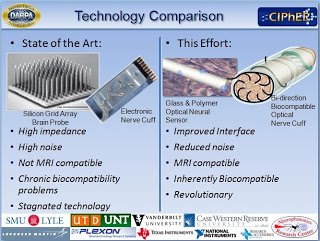Ad Support : Nano Technology Netbook Technology News Computer Software
Here is a 19 page pdf presentation by Marc Christensen on the approach, methods, challenges and issues with neurophotonics.
Funded by a Department of Defense initiative dedicated to audacious challenges and intense time schedules, the Neurophotonics Research Center will develop two-way fiber optic communication between prosthetic limbs and peripheral nerves.
This connection will be key to operating realistic robotic arms, legs and hands that not only move like the real thing, but also “feel” sensations like pressure and heat.
Successful completion of the fiber optic link will allow for sending signals seamlessly back and forth between the brain and artificial limbs, allowing amputees revolutionary freedom of movement and agility.
This can also lead to medical breakthroughs like brain implants for the control of tremors, neuro-modulators for chronic pain management and implants for patients with spinal cord injuries.
• Action Potentials are flow of sodium & potassium ions.
• MEAs (Multi-electrode arrays) work from sensing ion flux at double Helmholtz layer near electrode.
• What is the signal:
– Change in Ionic concentrations
– Moving charges (ions): electromagnetic disturbance
• more than 50 microVolts / 100 micrometers (MEA signal levels)
Interest in Fiber to the Brain
• MRI & Bio compatibility: glass and plastic.
• Dense signaling with low crosstalk.
• Flexible probes to maintain alignment.
• Hope for improved sensitivity.
• Host of different applications:
– Diagnostic, prosthetic, …
Leveraging Fluorescence
• Gold Nano-particles fluoresce under illumination.
• Spectrum shifts based on particle surroundings (~2meV reported).
• Can be designed to attract ions.
• Challenges: – Time scales (?), reuse
Challenges for Neurophotonic Sensing
• Transduce Action Potential into optically measureable quantity.
• Modes: – Ionic concentration / flux:
• phoresis, Δn, …
– Electromagnetic field:
• Electro-optic effect Δn, Magneto-optic effect Δn, physical change Δd, …
• Combinations and isolations of the above.
• Field Overlap
• Packaging
Questions to be Answered (2009)
• What is the minimum level of control-signal information required to recover a range of activities of daily living in both military and civilian situations?
• What are the challenging technical issues and fundamental / practical limits of prostheses systems based on each of the sources of neural-signal
information? How close to those limits are we now? How might these
challenges be overcome?
• What are the fundamental knowledge gaps that are holding back the
development and transition of emerging RE-NET capabilities into clinical use? How might these gaps be filled?
• What alternative approaches (“new ideas”) might yield revolutionary
performance improvements? Estimate the expected performance
improvements for each approach.
• What are the most significant problems for which new DARPA investments
can be expected to make a real difference in advancing fundamental
knowledge and RE-NET systems?
• What overall program structure and funding mechanisms should DARPA
consider as effective means for conducting a RE-NET program?
If you liked this article, please give it a quick review on Reddit, or StumbleUpon. Thanks
Supporting Advertising
Business Success
How to Make Money
Executive Jobs
Paid Surveys
Thank You

Brian Wang is a Futurist Thought Leader and a popular Science blogger with 1 million readers per month. His blog Nextbigfuture.com is ranked #1 Science News Blog. It covers many disruptive technology and trends including Space, Robotics, Artificial Intelligence, Medicine, Anti-aging Biotechnology, and Nanotechnology.
Known for identifying cutting edge technologies, he is currently a Co-Founder of a startup and fundraiser for high potential early-stage companies. He is the Head of Research for Allocations for deep technology investments and an Angel Investor at Space Angels.
A frequent speaker at corporations, he has been a TEDx speaker, a Singularity University speaker and guest at numerous interviews for radio and podcasts. He is open to public speaking and advising engagements.







